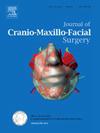双侧颅面小畸形患儿的三维头颅形态特征分析。
IF 2.1
2区 医学
Q2 DENTISTRY, ORAL SURGERY & MEDICINE
引用次数: 0
摘要
目的:颅面小畸形(CFM)是第二常见的先天性颅面畸形,由于常规的头颅测量术不能准确评估面部不对称,因此在双侧病例中表现不佳。本研究旨在利用三维(3D)头颅测量分析来表征双侧CFM儿童的颅面形态。材料和方法:对8例双侧CFM患者和10例年龄/性别匹配的正常患者进行回顾性三维头颅测量分析。建立了以法兰克福水平面(FHP)、中矢状面(MSP)和纳西恩垂直线(CP)为参考平面的坐标系。15个线性和角度测量评估上颌、下颌骨、下巴和咬合参数。根据Pruzansky-Kaban分级法,按双侧下颌缺损严重程度分层(A组:相似;B组:不同)。统计比较采用独立t检验(CFM与对照组)和Mann-Whitney U检验(亚组),Pearson相关分析探索变量关系。结果:双侧CFM患者的牙颌高度明显降低(Co-Go: p)。结论:双侧CFM主要表现为咬合平面后倾斜,下颌后嵴明显。咬合平面和下巴会不断向更严重的一侧偏移。当双侧下颌骨受累程度相近时,下颌偏斜往往较轻,导致面部不对称较轻。本文章由计算机程序翻译,如有差异,请以英文原文为准。
Three-dimensional cephalometric analysis of morphological characteristics in children with bilateral craniofacial microsomia
Purpose
Craniofacial microsomia (CFM), the second most common congenital craniofacial anomaly, is poorly characterized in bilateral cases because conventional cephalometry cannot accurately assess facial asymmetry. This study aims to characterize craniofacial morphology in children with bilateral CFM using three-dimensional (3D) cephalometric analysis.
Materials and methods
A retrospective 3D cephalometric analysis was conducted on 8 bilateral CFM patients and 10 age-/sex-matched normal patients as controls. A coordinate system was established with three reference planes: the Frankfurt Horizontal Plane (FHP), the Midsagittal Plane (MSP) and the Nasion Perpendicular Plane (CP). Fifteen linear and angular measurements assessed maxillary, mandibular, chin, and occlusal parameters. Subgroups were stratified by bilateral mandibular deficiency severity according to Pruzansky-Kaban classification (Group A: similar; Group B: different). Statistical comparisons utilized independent t-tests (CFM vs. controls) and Mann-Whitney U tests (subgroups), with Pearson's correlation analysis exploring variable relationships.
Results
Bilateral CFM patients exhibited significant reductions in ramal height (Co-Go: p < 0.001) and mandibular body length (Go-Me: p < 0.001), a posteriorly inclined occlusal plane (OP-FHP: 27.63° ± 5.50° vs. 8.13° ± 3.33°, p < 0.001), and pronounced chin retrusion (Me-NP: 46.08 ± 6.66 mm vs. 8.28 ± 7.71 mm, p < 0.001) and lateral deviation (Me-MSP: 5.84 ± 4.64 mm vs. 1.73 ± 0.93 mm, p < 0.05). Me-NP and Me-MSP differed significantly in subgroup analyses. Pearson correlation analysis revealed strong associations between Me-NP and Me-MSP and OP-MSP, posterior maxillary height (U6-FHP) and Co-Go.
Conclusion
Bilateral CFM is mainly characterized by posteriorly inclined occlusal plane and pronounced mandibular retrognathia. The occlusal plane and chin will consistently deviate toward the more severely affected side. When bilateral mandibular involvement is similar in extent, chin deviation tends to be mild, resulting in less severe facial asymmetry.
求助全文
通过发布文献求助,成功后即可免费获取论文全文。
去求助
来源期刊
CiteScore
5.20
自引率
22.60%
发文量
117
审稿时长
70 days
期刊介绍:
The Journal of Cranio-Maxillofacial Surgery publishes articles covering all aspects of surgery of the head, face and jaw. Specific topics covered recently have included:
• Distraction osteogenesis
• Synthetic bone substitutes
• Fibroblast growth factors
• Fetal wound healing
• Skull base surgery
• Computer-assisted surgery
• Vascularized bone grafts

 求助内容:
求助内容: 应助结果提醒方式:
应助结果提醒方式:


